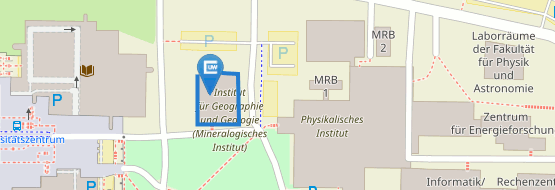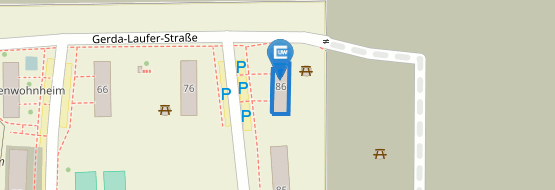Prof. Dr. Hannes Taubenböck

Lehrstuhlinhaber des
Lehrstuhl für Globale Urbanisierung und Fernerkundung
in Kooperation mit dem Deutschen Zentrum für Luft- und Raumfahrt e.V.
![]() +49 (0)931 31 86778
+49 (0)931 31 86778
![]() +49 (0)8153 28-2480
+49 (0)8153 28-2480
hannes.taubenboeck@uni-wuerzburg.de
hannes.taubenboeck@dlr.de
Thematisch:
- Erforschung globaler Urbanisierung:
- Flächen- und Bevölkerungswachstum
- Expansion von Siedlungsräumen in Naturlandschaften
- Urbane Strukturanalysen
- Kategorisierung von Stadttypen
- Erforschung informeller Siedlungsformen
- Slumexpansion und Strukturen urbaner Armut
- Flüchtlingslager
- Forschung zur Exposition und Vulnerabilität gegenüber Naturgefahren
- Klassifikation und Bewertung exponierter Assets wie Gebäude
- Forschung zur Exposition gegenüber Umweltveränderungen
- Urbane Hitzeinseln
- Luftqualität
- Lärm
- Forschung zu Migration
- Kombination fernerkundlicher Daten mit (sozialen) Medien
- Studien zu Tier-Umwelt Beziehungen
Methodisch:
- Klassifikationsmethoden (regelbasiert/ML/KI) für fernerkundliche Daten
- Multi-modale Datenanalyse (Fernerkundung, (soziale) Medien, etc.)
- Geographische Analysen zu räumlichen Mustern
nach Vereinbarung
Seit Oktober 2022
Lehrstuhlinhaber des Lehrstuhl für Globale Urbanisierung und Fernerkundung an der Julius-Maximilians Universität Würzburg.
Seit 2009
Lehrveranstaltungen an der Julius-Maximilians Universität Würzburg.
2015 - 2019
Habilitation an der Julius-Maximilians Universität Würzburg ; Titel: Remote Sensing for the Analysis of Global Urbanization.
2005 - 2008
Promotion (Dr. rer. nat.) an der Julius-Maximilians Universität Würzburg; Titel:Vulnerabilitätsabschätzung der Megacity Istanbul mit Methoden der Fernerkundung.
1999 - 2004
Studium der Geographie mit den Nebenfächern Fernerkundung, Raumplanung und Geoinformatik (zusätzliches Nebenfach bis Vordiplom: Physik) an der Ludwig-Maximilians-Universität München.
-
How do rural industrial sites impact migrant motives and the socio-economic conditions of local and migrant populations?. . In Scientific African, 27(e02546), p. 18. 2025.
-
Earth observations reveal impacts of climate variability on maize cropping systems in sub-Saharan Africa. . In GIScience and Remote Sensing, 62(1), p. 19. 2025.
-
The voices of the displaced: Mobility and Twitter conversations of migrants of Ukraine in 2022. . In Information Processing & Management, 61(3), p. 103670. 2024.
-
Harmonized NDVI time-series from Landsat and Sentinel-2 reveal phenological patterns of diverse, small-scale cropping systems in East Africa. . In Remote Sensing Applications: Society and Environment, 35, p. 101230. 2024.
-
How does pedestrian permeability vary in and across cities? A fine-grained assessment for all large cities in Germany. . In Computers, Environment and Urban Systems, 110, p. 102115. 2024.
-
Liveability in large housing estates in Germany – Identifying differences based on a novel concept for a walkable city. . In Landscape and Urban Planning, 251. 2024.
-
Planned, unplanned, or in-between? A concept of the intensity of plannedness and its empirical relation to the built urban landscape across the globe. . In Landscape and Urban Planning, 233, p. 104711. 2023.
-
EU Cohesion Policy on the Ground: Analyzing Small-Scale Effects Using Satellite Data. . In Regional Science and Urban Economics. 2023.
-
Spatial delineation of urban corridors in North America: An approach incorporating fuzziness based on multi-source geospatial data. . In Cities, 133, p. 104129. 2023.
-
Border regions across the globe: Analyzing border typologies, economic and political disparities, and development dynamics. . In Applied Geography, 151, p. 102866. 2023.
-
The Individual Walkable Neighborhood - Evaluating people-centered spatial units focusing on urban density. . In Computers, Environment and Urban Systems, 99. 2023.
-
Greener cities cost more green: Examining the impacts of different urban expansion patterns on NPP. . In Building and Environment, 228. 2023.
-
Are public green spaces distributed fairly? A nationwide analysis based on remote sensing, OpenStreetMap and census data. . In Geocarto International, 38(1). Taylor & Francis, 2023.
-
YOLO object detection models can locate and classify broad groups of flower-visiting arthropods in images. . In Nature Sci Rep, 13(16364). 2023.
-
Does urban growth mean the loss of greenness? A multi-temporal analysis for Chinese cities. . In Science of The Total Environment, 898, p. 166373. 2023.
-
Learning income levels and inequality from spatial and sociodemographic data in Germany. . In Applied Geography, 159, p. 103058. 2023.
-
A structural catalog of the settlement morphology in refugee and IDP camps. . In International Journal of Geographical Sciences., 37(6), pp. 1338–1364. 2023.
-
Quantifying urban heat exposure at fine scale - modeling outdoor and indoor temperatures using citizen science and VHR remote sensing. . In Urban Climate, 49, p. 101522. 2023.
-
Deep multitask learning with label interdependency distillation for multicriteria street-level image classification. . In ISPRS Journal of Photogrammetry and Remote Sensing. 2023.
-
Litter on the streets - solid waste detection using VHR images. . In European Journal of Remote Sensing, 56(1). 2023.
-
The Unseen—An Investigative Analysis of Thematic and Spatial Coverage of News on the Ongoing Refugee Crisis in West Africa. . In ISPRS Int. J. Geo-Inf., 12. 2023.
-
In the tension between large-scale analysis and accuracy - Identifying and analysing intra-urban (sub-)centre structures comparing official 3D-building models and TanDEM-X nDSMs. . In Computers, Environment and Urban Systems, 102, p. 101953. 2023.
-
Deep Neural Network Regression for Digital Surface Model Generation with Sentinel-2 Imagery. . In IEEE Journal of Selected Topics in Applied Earth Observations and Remote Sensing. 2023.
-
Quantitative assessment and comparison of urban patterns in Germany and the United States. . In Computers, Environment and Urban Systems, 100, p. 101920. 2023.
-
Spatially-optimized urban greening for reduction of population exposure to land surface temperature extremes. . In Nature communications, 14(2903). 2023.
-
The UnseentextemdashAn Investigative Analysis of Thematic and Spatial Coverage of News on the Ongoing Refugee Crisis in West Africa. . In ISPRS International Journal of Geo-Information, 12(4), p. 175. MDPI AG, 2023.
-
Deep Neural Network Regression for Normalized Digital Surface Model Generation With Sentinel-2 Imagery. . In IEEE Journal of Selected Topics in Applied Earth Observations and Remote Sensing, 16, pp. 8508–8519. 2023.
-
New paper published on Data-driven prediction of COVID-19 cases in Germany in the journal BMC Medical Research Methodology. . In BMC Medical Research Methodology., 22(116). 2022.
-
Intra-metropolitan Employment Concentration in the 21st Century: A comparative study of U.S. and German Metropolitan Areas. . In Journal of Urban Affairs. 2022.
-
2So2Sat POP – A Curated Benchmark Data Set for Population Estimation from Space on a Continental Scale. . In Nature Scientific Data., 9(715). 2022.
-
Mapping of small water bodies with integrated spatial information for time series images of optical remote sensing. . In Journal of Hydrology, 614, p. 128580. 2022.
-
Time series enable the characterization of small-scale vegetation dynamics that influence fine-scale animal behavior – an example from white storks’ foraging behavior. . In Remote Sensing in Ecology and Conservation. 2022.
-
Selection of unlabeled source domains for domain adaptation in remote sensing. . In Array, 15, p. 100233. 2022.
-
Empiric recommendations for population disaggregation under different data scenarios. . In PLOS ONE, 17(9), pp. 1–29. Public Library of Science, 2022.
-
Housing forms of poverty in Europe - A categorization based on literature research and satellite imagery. . In Applied Geography, 149, p. 102820. 2022.
-
Dynamics of intra-urban employment geographies: A comparative study of U.S. and German metropolitan areas. . In Journal of Urban Affairs. 2022.
-
Geo-Information Harvesting from Social Media Data. . 2022.
-
Estimating housing vacancy rates at block level: The example of Guiyang, China. . In Landscape and Urban Planning, 224, p. 104431. 2022.
-
Earth Observation and Artificial Intelligence: Understanding emerging ethical issues and opportunities. . IEEE - Institute of Electrical and Electronics Engineers, 2022.
-
Benefits of Global Earth Observation Missions for Exposure Estimation and Earthquake Loss Modelling textendash Evidence from Santiago de Chile, Chile. . Research Square Platform LLC, 2022.
-
To be, or not to be ‘urban’? A multi-modal method for the differentiated measurement of the degree of urbanization. . In Computers, Environment and Urban Systems, 95, p. 101830. 2022.
-
Automated building characterization for seismic risk assessment using street-level imagery and deep learning. . In ISPRS Journal of Photogrammetry and Remote Sensing, 180, pp. 370–386. 2021.
-
Deep Learning-Based Generation of Building Stock Data from Remote Sensing for Urban Heat Demand Modeling. . In ISPRS Journal of Photogrammetry and Remote Sensing, 10(23), pp. 1–20. 2021.
-
Which city is the greenest? A multi-dimensional deconstruction of city rankings. . In Computers, Environment and Urban Systems, 89, p. 101687. 2021.
-
Defining pathways to healthy sustainable urban development. . In Environment International, 146, p. 106236. 2021.
-
Spatial and semantic effects of LUCAS samples on fully automated land use/land cover classification in high-resolution Sentinel-2 data. . In International Journal of Applied Earth Observation and Geoinformation, 88, p. 102065. 2020.
-
Spectral-Spatial Classification Integrating Band Selection for Hyperspectral Imagery With Severe Noise Bands. . In IEEE Journal of Selected Topics in Applied Earth Observations and Remote Sensing, 13, pp. 1597–1609. 2020.
-
Satellite-Based Mapping of Urban Poverty With Transfer-Learned Slum Morphologies. . In IEEE Journal of Selected Topics in Applied Earth Observations and Remote Sensing, 13, pp. 5251–5263. 2020.
-
Continental-scale mapping and analysis of 3D building structure. . In Remote Sensing of Environment, 245, p. 111859. 2020.
-
Multistrategy ensemble regression for mapping of built-up density and height with Sentinel-2 data. . In ISPRS Journal of Photogrammetry and Remote Sensing, 170, pp. 57–71. 2020.
-
Inferring floor area ratio thresholds for the delineation of city centers based on cognitive perception. . In Environment and Planning B: Urban Analytics and City Science. Sage Publications, 2020.
-
Seven city types representing morphologic configurations of cities across the globe. . In Cities, 105, p. 102814. 2020.
-
Deriving urban mass concentrations using TanDEM-X and Sentinel-2 data for the assessment of morphological polycentricity. . In IEEE International Geoscience and Remote Sensing Sysposium 2020, pp. 4219–4222. 2020.
-
Mapping Plastic Greenhouses Using Spectral Metrics Derived From GaoFen-2 Satellite Data. . In IEEE Journal of Selected Topics in Applied Earth Observations and Remote Sensing, 13, pp. 49–59. 2020.
-
Uncertainties of Human Perception in Visual Image Interpretation in Complex Urban Environments. . In IEEE Journal of Selected Topics in Applied Earth Observations and Remote Sensing, 13, pp. 4229–4241. 2020.
-
Urbanization that hides in the dark – Spotting China’s “ghost neighborhoods” from space. . In Landscape and Urban Planning, 200, p. 103822. 2020.
-
Mapping Plastic Greenhouses Using Spectral Metrics Derived From GaoFen-2 Satellite Data. . In IEEE Journal of Selected Topics in Applied Earth Observations and Remote Sensing, (49-59). 2020.
-
Measuring the spatial hierarchical urban system in China in reference to the Central Place Theory. . In Habitat International, 105, p. 102264. 2020.
-
The dynamics of poor urban areas - analyzing morphologic transformations across the globe using Earth observation data. . In Cities, 107, p. 102905. 2020.
-
Analyzing Links between Spatio-Temporal Metrics of Built-Up Areas and Socio-Economic Indicators on a Semi-Global Scale. . Multidisciplinary Digital Publishing Institute, 2020.
-
Satellitendaten zur Erfassung gesundheitsrelevanter Umweltbedingungen: Beispiele und interdisziplinäre Potenziale. . Springer, 2020.
-
Misperceptions of Predominant Slum Locations? Spatial Analysis of Slum Locations in Terms of Topography Based on Earth Observation Data. . In Remote Sensing, 12(15), p. 2474. MDPI AG, 2020.
-
Satellitendaten zur Erfassung gesundheitsrelevanter Umweltbedingungen: Beispiele und interdisziplinäre Potenziale. . In Bundesgesundheitsblatt - Gesundheitsforschung - Gesundheitsschutz, 63(8), pp. 936–944. 2020.
-
Air Quality Monitoring and Data Management in Germany - Status Quo and Suggestions for Improvement. . 2020.
-
Modelling the impact of the urban spatial structure on the choice of residential location using ‘big earth data’ and machine learning. . In 2019 Joint Urban Remote Sensing Event (JURSE), pp. 1–4. 2019.
-
Has Dongying developed to a ghost city? - Evidence from multi-temporal population estimation based on VHR remote sensing and census counts. . In Computers, Environment and Urban Systems, 78, p. 101372. 2019.
-
A new ranking of the world’s largest cities—Do administrative units obscure morphological realities?. . In Remote Sensing of Environment, 232, p. 111353. 2019.
-
Patterns of Eastern European Urbanisation in the Mirror of Western Trends – Convergent, Unique or Hybrid?. . In Environment and Planning B: Urban Analytics and City Science., 46(7), pp. 1206–1225. 2019.
-
Urbanization between compactness and dispersion – Designing a spatial model for measuring 2D binary settlement landscape configurations. . In International Journal of Digital Earth, 12(6), pp. 679–698. 2019.
-
Understanding an urbanizing planet: Strategic directions for remote sensing. . In Remote Sensing of Environment, 228, pp. 164–182. 2019.
-
Sensitivity of slum size distributions as a function of spatial parameters for slum classification. . In 2019 Joint Urban Remote Sensing Event (JURSE), pp. 1–4. 2019.
-
How dynamic are slums? EO-based assessment of Kibera’s morphologic transformation. . In 2019 Joint Urban Remote Sensing Event (JURSE), pp. 1–4. 2019.
-
Slum Mapping in Imbalanced Remote Sensing Datasets Using Transfer Learned Deep Features. . In 2019 Joint Urban Remote Sensing Event (JURSE), pp. 1–4. 2019.
-
Size Distributions for Morphological Slums in Asia and South America. . In 2019 Joint Urban Remote Sensing Event (JURSE), pp. 1–4. 2019.
-
Patterns of Eastern European urbanisation in the mirror of Western trends textendash Convergent, unique or hybrid?. . In Environment and Planning B: Urban Analytics and City Science, 46(7), pp. 1206–1225. SAGE Publications, 2019.
-
Inferring floor area ratio thresholds for the delineation of city centers based on cognitive perception. . In Environment and Planning B: Urban Analytics and City Science, p. 239980831986934. SAGE Publications, 2019.
-
A transferable remote sensing approach to classify building structural types for seismic risk analyses: the case of Val d’Agri area (Italy). . In Bulletin of Earthquake Engineering, 17(9), pp. 4825–4853. 2019.
-
Are the Poor Digitally Left Behind? Indications of Urban Divides Based on Remote Sensing and Twitter Data. . In ISPRS International Journal of Geo-Information, 7(8), p. 304. MDPI AG, 2018.
-
Are We in Boswash Yet? A Multi-Source Geodata Approach to Spatially Delimit Urban Corridors. . In ISPRS International Journal of Geo-Information, 7(1), p. 15. MDPI AG, 2018.
-
The morphology of the Arrival City - A global categorization based on literature surveys and remotely sensed data. . In Applied Geography, 92, pp. 150–167. 2018.
-
Measuring morphological polycentricity - A comparative analysis of urban mass concentrations using remote sensing data. . In Computers, Environment and Urban Systems, 64, pp. 42–56. 2017.
-
New spatial dimensions of global cityscapes: From reviewing existing concepts to a conceptual spatial approach. . In Journal of Geographical Sciences, 26(3), pp. 355–380. 2016.
-
The Physical Density of the CitytextemdashDeconstruction of the Delusive Density Measure with Evidence from Two European Megacities. . In ISPRS International Journal of Geo-Information, 5(11), p. 206. MDPI AG, 2016.
-
A Global Inventory of Urban Corridors Based on Perceptions and Night-Time Light Imagery. . In ISPRS International Journal of Geo-Information, 5(12), p. 233. MDPI AG, 2016.
-
The spatial network of megaregions - Types of connectivity between cities based on settlement patterns derived from EO-data. . In Computers, Environment and Urban Systems, 54, pp. 165–180. 2015.
-
Wo beginnt die Stadt? Urbane Fernerkundung für stadtgeographische Forschung. . Netzwerk Stadt und Landschaft, 2015.
-
The physical face of slums: a structural comparison of slums in Mumbai, India, based on remotely sensed data. . In Journal of Housing and the Built Environment, 29(1), pp. 15–38. 2014.
-
New dimensions of urban landscapes: The spatio-temporal evolution from a polynuclei area to a mega-region based on remote sensing data. . In Applied Geography, 47, pp. 137–153. 2014.
-
Satellites: make data freely accessible. . In Nature, 498(37), p. 37. 2013.
-
Delineation of Central Business Districts in mega city regions using remotely sensed data. . In Remote Sensing of Environment, 136, pp. 386–401. 2013.
-
Monitoring urbanization in mega cities from space. . In Remote Sensing of Environment, 117, pp. 162–176. 2012.
-
Object-based feature extraction using high spatial resolution satellite data of urban areas. . In Journal of Spatial Science, 55(1), pp. 111–126. 2010.
-
Urbanization in India – Spatiotemporal analysis using remote sensing data. . In Computers, Environment and Urban Systems, 33(3), pp. 179–188. 2009.
-
Last-Mile preparation for a potential disaster – Interdisciplinary approach towards tsunami early warning and an evacuation information system for the coastal city of Padang, Indonesia. . In Natural Hazards and Earth System Sciences, 9(4), pp. 1509–1528. 2009.
-
A conceptual vulnerability and risk framework as outline to identify capabilities of remote sensing. . In Natural Hazards and Earth System Sciences, 8(3), pp. 409–420. 2008.
-
The capabilities of remote sensing to support disaster management: A case study of the district Üsküdar in Istanbul, Turkey. . In Turkish Journal of Disaster, 2(1). 2007.



